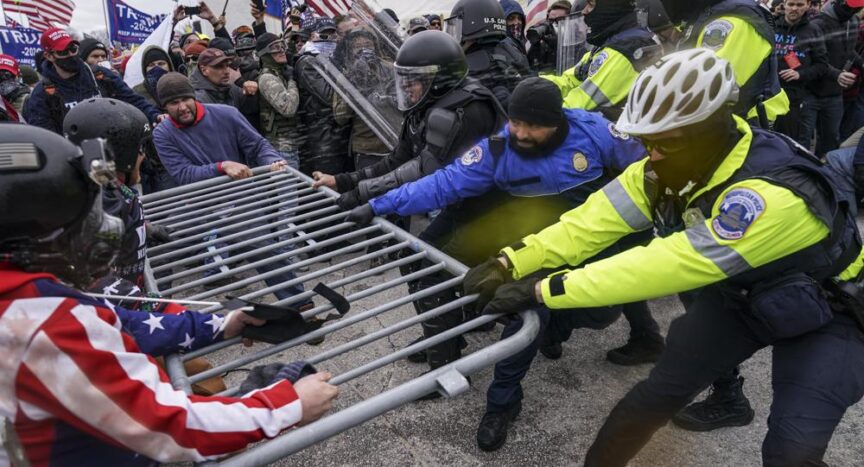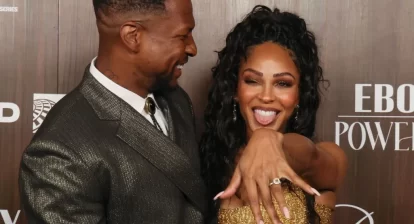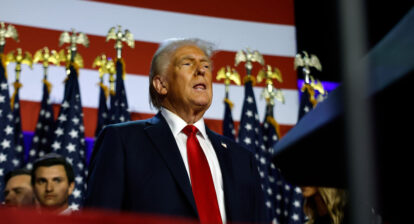As we’ve seen in Springfield, Ohio, the language of division has been weaponized against Black and marginalized communities for decades, deepening systemic inequities and weakening the very fabric of our democracy.
Editor’s note: The following article is an op-ed, and the views expressed are the author’s own. Read more opinions on theGrio.
The recent political rhetoric and intimidation directed towards the community of Springfield, Ohio, and Black Haitian refugees who reside there underscores that political violence in the United States isn’t just escalating — it’s being normalized. Every day, our political dialogue becomes more dehumanizing and disturbingly violent. For communities of color, this reality is painfully familiar. The language of division has been weaponized against Black and marginalized communities for decades, deepening systemic inequities and weakening the very fabric of our democracy.
Racial disparities not only influence how political violence is policed and prosecuted but also how the media portrays these crises to the public and decision-makers. If government and philanthropic efforts are to address this threat, they must do so through a racial equity lens — one that avoids over-criminalization, centers those most impacted, and embraces intercommunal cooperation. Local governance will be pivotal to making these efforts real.
Local government remains one of the most powerful yet underutilized tools we have for addressing political violence and promoting racial equity. In my decades of civil rights work, I’ve seen how decisions made in city halls, county commissions, and local police boards shape the daily lives of people in ways that national politics often overlook. It’s in these spaces that we can disrupt the conditions fueling political violence and build the infrastructure for peace, equity, and justice.
But local governments do more than create policy; they can also set the narrative. City councils, mayors, community leaders and police chiefs have the power to frame how violence and protest are understood within their communities. They can choose to invest in alternative responses — through community-led initiatives, local dialogues to address inter-communal tensions, and restorative justice practices that prioritize reconciliation and restitution over punishment. This is essential to ensuring that solutions don’t default to over-criminalizing Black and Latino communities, a pattern we’ve seen for far too long.
Consider Daniel Clement’s study, “Framing the 2020 Black Lives Matter Protests: A Socio-Legal Study of Partisan News Coverage,” from Lund University. It highlights stark differences in media coverage of the 2020 Black Lives Matter protests compared to the Jan. 6 Capitol insurrection. Media outlets were over twice as likely to use negative terms like “riot” or “violence” when describing the BLM protests, while coverage of the Capitol insurrection employed softer terms like “protest” or “march.” This discrepancy underscores the racial and partisan biases inherent in media representation.
This biased framing leads audiences to view Black-led movements as inherently violent, despite evidence to the contrary. Skewed reporting shapes societal — and law enforcement — responses to political violence. Local governance has the potential to reset this narrative, fostering justice rather than perpetuating inequity.
Lifestyle
- How a doctor at Johns Hopkins has been using diabetes medication to treat alopecia
- Taraji P. Henson reveals what inspires her advocacy
- ‘Choosing Motherhood,’ episode 7: Eboni K. Williams pushes back on negative perceptions of single motherhood
- T.I., Tiny, and OMG Girlz win $71 million following lawsuit against toy manufacturer
- Could AI help detect a condition disproportionately impacting Black people?
As I watched the Jan. 6 insurrection unfold, I couldn’t help but think of how differently law enforcement has responded to Black protests and non-violent civil disobedience. According to theGrio’s Michael Harriot, even though white people overwhelmingly made up the far majority of George Floyd protestors, 53% of those arrested were Black. But here’s the shocking part: Even in the nearly all-white Capitol insurrection, 13.9% of those arrested were people of color. This disparity is jarring and exposes the depth of racial bias in law enforcement, even amid a “white riot.” It demonstrates how systemic racism permeates every aspect of how we handle protests and political violence — further highlighting an opportunity for local governments to implement reforms in partnership with federal and state government that focus on equity, rather than defaulting to punitive measures that disproportionately impact communities of color.
Local governments can create environments where all people, regardless of race, feel safe, heard, and empowered. This is where governance and community intersect. By implementing policies that challenge structural racism and ensure fair treatment, local leaders have the power to transform systems that perpetuate inequity.
Bipartisan solutions can also emerge here. Restorative justice — a policy focused on reconciliation between offenders, victims, and the community — could resonate with both progressives and conservatives. It offers a pathway that doesn’t rely on mass incarceration, which progressives oppose due to its disproportionate impact on communities of color, and which many conservatives view as costly and ineffective. Restorative justice reduces recidivism, strengthens community bonds, and promotes personal accountability — values that resonate across the political spectrum.
Media representation plays a critical role in how political violence is understood. White perpetrators of political violence are often described as “mentally ill” or “troubled,” while Black and brown individuals are labeled “criminals” or “threats.” This biased coverage perpetuates the narrative that violence by white individuals is an anomaly, while violence committed by people of color is seen as inherent to their communities. This public perception influences how policymakers, law enforcement, and local governments respond to acts of violence.
The normalization of political violence is not abstract — it has real and deadly consequences for Black, Indigenous, and other communities of color. A PBS NewsHour/NPR/Marist poll revealed that one in five Americans believes political violence can be justified. This growing acceptance of violence is particularly dangerous for those already targeted by systemic racism and discrimination.
Addressing political violence also means confronting the dangerous antisemitic and racist narratives that fuel it. History is littered with texts like “The Protocols of the Learned Elders of Zion” — an antisemitic hoax that justified hatred against Jews. Similarly, “The Camp of the Saints” fuels anti-immigrant sentiment with dystopian depictions of a migrant “invasion,” while “The Turner Diaries” has inspired acts of domestic terrorism. These bigoted narratives converge in the Great Replacement Theory, a made-up antisemitic conspiracy claiming that white populations are being intentionally “replaced” by people of color, immigrants by a Jewish conspiracy — a belief that has motivated racist and xenophobic mass shootings and political violence worldwide.
These ideologies have real-world impacts. From the anti-Jewish Tree of Life Synagogue shooting to the anti-immigrant El Paso Walmart attack, where the shooters cited the Great Replacement Theory, the rhetoric of hate continues to incite violence, amplified by online echo chambers, political leaders, and cultural figures exploiting fear for their own gain.
Today, these dangerous ideologies are normalizing political violence in even more visceral ways. The violence between Gaza and Israel has reverberated here in the U.S., leading to protests and, at times, physical confrontations. Jewish and Muslim communal spaces have become targets as overseas violence fuels animosity and tension in our streets. This cycle of violence, fueled by historical and contemporary narratives of division, shows how quickly hatred can escalate into harm.
Local governments, civil society and cultural leaders must confront these narratives by promoting inclusive, truthful, and humanizing stories that counter the hatred perpetuated by texts like “The Protocols” or “The Turner Diaries.” We must address the root causes of division and build bridges between communities vulnerable to these ideologies.
Subcultures and fandoms, often dismissed as marginal, can serve as vital counterpoints to these divisive narratives. These spaces offer new stories of solidarity and resistance, challenging the rhetoric of fear with a language of hope and inclusion.
We’re at a critical juncture. This is not just about partisan politics. Solutions to political violence must be rooted in fairness, equity, and community engagement, and local governments — along with cultural movements — are uniquely positioned to lead this charge.
Beyond government, cultural and educational institutions must also combat harmful rhetoric and promote racial equity. Schools, media outlets, and the arts are critical spaces where new narratives can emerge. Musicians, artists, and grassroots cultural movements have long played pivotal roles in promoting resilience and democracy. Subcultures and fandoms have become dynamic spaces for activism, fostering empathy and solidarity across divides.
Each of us has a role to play in shaping a just and peaceful future. Whether by engaging with local officials, supporting grassroots organizations, or participating in subcultures, we must resist the forces of violence and division. This isn’t just up to our leaders—it’s up to all of us to build a democracy that reflects the values of equity, justice, and unity.
Political violence doesn’t begin with a gun or a mob — it begins with a word, a policy, and how we choose to govern. Now is the time to reclaim the power of language, culture, and governance to build a democracy where everyone — especially the most marginalized—is safe, respected, and free.
Eric K. Ward is executive vice president of Race Forward, the only American recipient of the Civil Courage Prize, and a Senior Fellow with the Southern Poverty Law Center.
!function(){var g=window;g.googletag=g.googletag||{},g.googletag.cmd=g.googletag.cmd||[],g.googletag.cmd.push(function(){g.googletag.pubads().setTargeting(“has-featured-video”,”true”)})}();





